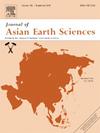Diverse geodynamic settings of the Egyptian ophiolites: Geochemical insights from Wadi Ghadir and Gabal Abu Dahr
IF 2.7
3区 地球科学
Q2 GEOSCIENCES, MULTIDISCIPLINARY
引用次数: 0
Abstract
In the context of the ongoing debate on the genetic aspects of Egyptian ophiolites, understanding the geodynamic setting of significant ophiolitic complexes is crucial. Here, we investigate the Wadi Ghadir (WG) and Gabal Abu Dahr (AD) ophiolites to elucidate their tectonic setting and evolution. Combining whole-rock trace element geochemical data of crustal and mantle section rocks with mineral chemistry analyses of relict clinopyroxene and Cr-spinel, we delineate the geochemical signatures indicative of their tectonic setting. The WG represents a nearly complete ophiolite sequence, while the AD complex is a dismembered ophiolite nappe encompassing serpentinized peridotite, variably sheared metagabbro, and mélange matrix. The trace element patterns of the crustal section rocks in both ophiolites exhibit enrichments in LILE and depletions in HFSE, suggesting formation in a supra-subduction zone (SSZ). The low Ti contents and fractionated chondrite-normalized REE patterns of clinopyroxenes from both studied ophiolites further support the subduction-induced characteristics. The highly elevated Cr# of Cr-spinel in the WG and AD serpentinites, alongside their high Mg# and low TiO2 contents, resemble those of the forearc basalts and boninites, indicative of extensive melt extraction. Despite the shared features of progressive evolution to boninite-similar geochemistry, the AD ophiolite is deemed unlikely to have experienced the MORB or backarc environments. Conversely, the WG ophiolite has geochemical signatures inferring transitioning from back-arc MORB-like lithosphere to the SSZ setting. Although originating from distinct geodynamic settings, these ophiolites can be conceptualized as representing a Tonian-Cryogenian sub-arc lithosphere (∼730–700 Ma) in the Egyptian Eastern Desert, showcasing varied responses to subduction-related processes.

埃及蛇绿岩的不同地球动力学背景:来自Wadi Ghadir和Gabal Abu Dahr的地球化学见解
在关于埃及蛇绿岩遗传方面的持续争论的背景下,了解重要蛇绿岩复合体的地球动力学背景至关重要。本文对Wadi Ghadir (WG)和Gabal Abu Dahr (AD)蛇绿岩进行了研究,以阐明它们的构造背景和演化。结合地壳和地幔剖面岩石的全岩微量元素地球化学资料,结合残余斜辉石和铬尖晶石的矿物化学分析,圈定了指示其构造背景的地球化学特征。WG代表了一个几乎完整的蛇绿岩序列,而AD复合体是一个断裂的蛇绿岩推覆体,包括蛇纹橄榄岩、变剪切变质长岩和msamulange基质。两种蛇绿岩的地壳剖面岩石微量元素模式均表现为LILE富集和HFSE亏缺,表明其形成于超俯冲带。两种蛇绿岩斜辉石的低钛含量和分选球粒陨石归一化稀土模式进一步支持了俯冲成因特征。WG和AD蛇纹岩中Cr尖晶石的Cr#含量高,Mg#含量高,TiO2含量低,与弧前玄武岩和boninites相似,表明存在广泛的熔融萃取。尽管AD蛇绿岩具有向类似白钨矿的地球化学演化的共同特征,但我们认为AD蛇绿岩不太可能经历过MORB或弧后环境。相反,WG蛇绿岩具有推断弧后morb样岩石圈向SSZ环境过渡的地球化学特征。虽然这些蛇绿岩起源于不同的地球动力学背景,但它们可以被定义为代表埃及东部沙漠的Tonian-Cryogenian亚弧岩石圈(~ 730-700 Ma),显示出对俯冲相关过程的不同响应。
本文章由计算机程序翻译,如有差异,请以英文原文为准。
求助全文
约1分钟内获得全文
求助全文
来源期刊

Journal of Asian Earth Sciences
地学-地球科学综合
CiteScore
5.90
自引率
10.00%
发文量
324
审稿时长
71 days
期刊介绍:
Journal of Asian Earth Sciences has an open access mirror journal Journal of Asian Earth Sciences: X, sharing the same aims and scope, editorial team, submission system and rigorous peer review.
The Journal of Asian Earth Sciences is an international interdisciplinary journal devoted to all aspects of research related to the solid Earth Sciences of Asia. The Journal publishes high quality, peer-reviewed scientific papers on the regional geology, tectonics, geochemistry and geophysics of Asia. It will be devoted primarily to research papers but short communications relating to new developments of broad interest, reviews and book reviews will also be included. Papers must have international appeal and should present work of more than local significance.
The scope includes deep processes of the Asian continent and its adjacent oceans; seismology and earthquakes; orogeny, magmatism, metamorphism and volcanism; growth, deformation and destruction of the Asian crust; crust-mantle interaction; evolution of life (early life, biostratigraphy, biogeography and mass-extinction); fluids, fluxes and reservoirs of mineral and energy resources; surface processes (weathering, erosion, transport and deposition of sediments) and resulting geomorphology; and the response of the Earth to global climate change as viewed within the Asian continent and surrounding oceans.
 求助内容:
求助内容: 应助结果提醒方式:
应助结果提醒方式:


